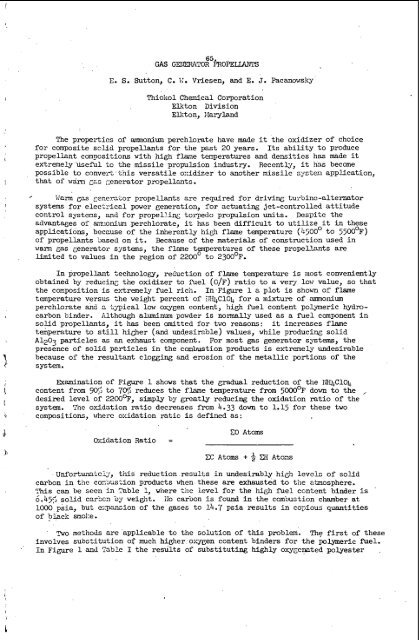secondary cells with lithium anodes and immobilized fused_salt
secondary cells with lithium anodes and immobilized fused_salt
secondary cells with lithium anodes and immobilized fused_salt
You also want an ePaper? Increase the reach of your titles
YUMPU automatically turns print PDFs into web optimized ePapers that Google loves.
I<br />
65.<br />
GAS GEHEPAT'OR PROPELTANTS<br />
E. S. Sutton, C. F:. Vriesen, <strong>and</strong> E. J. Pacano~?slrj<br />
I Thiokol Chenical Corporation<br />
Elkton Division<br />
Elkton, Xaryl<strong>and</strong><br />
I<br />
The properties of ammonium perchlorate have made it the oxidizer of choice<br />
for composite sclid propellants for the past 20 years. Its ability to produce<br />
propellant comFositions <strong>with</strong> high flane tenperatures <strong>and</strong> densities has made it<br />
extremely useal to the missile propulsion industry.<br />
Recently, it has become<br />
possible to convert this versatile oxidizer to another nissilc S;JS~UJ application,<br />
that of wdm gcs Generator propellats.<br />
I Werm gas Cenerztor propellants are required for driviw turbine-alternator<br />
I systems for electrical power generation, for actuating jet-controlled attitude<br />
control system, <strong>and</strong> for propellin(; torpedo propulsion units. Despite the<br />
advantages or' m.ioniun perchlorate, it has been difficult to utilize it in these<br />
applications, because of the inherently high flame temperature (b500° to 55OOOF)<br />
of propellants 'Jased on it. Because of the materials of construction used in<br />
warn gas cenerator systems, the flame temperatures of these propellants are<br />
limited to values in the region of 2200' to 2300OF.<br />
In propellant technology, rechction of flame temperature is most conveniently<br />
obtained by rcducix the oxidizer to el (G//F) ratio to a verj 1011 value, so that<br />
the conposition is extremely fie1 rich. In Figure 1 a plot is shown of flame<br />
temperature versus the weight percent of llH4Cl04 for a mixture of ammonium<br />
perchlorate ani 2 Q-pical low oxygen content, high fuel content polymeric hydrocarbon<br />
binder. Although aluminum powder is normally used as a fuel component in<br />
solid propellants, it has been omitted for two reasons: it increases flame<br />
temperature to still hi&er (<strong>and</strong> undesirzble) values, while producing solid<br />
A1203 particles as ul eyhaust component. For most gas generator systems, the<br />
presence of solid perticles in the coalrustion products is extremely undesirable<br />
because of the resultvlt clogging <strong>and</strong> erosion of the metallic portions of the<br />
system.<br />
I<br />
Emuination of Figure 1 shows that the gradual reduction of the IIHqClOq<br />
1, content from 9q: to 7% reduces the flame temperature from 5000'F down to the ,<br />
desired level of 22009, simply by greatly reducing the oxidation ratio of the<br />
!<br />
system. Tne oxidation ratio decreases from 4.33 down to 1.15 for these two<br />
9 compositions, vhere oxidation ratio is defined as:<br />
A)<br />
Oxidation Ratio =<br />
co Atoms<br />
CC Atoms + 3 Df Atoms<br />
Unfortunately, this reduction .results in undesirably hi& levels of solid<br />
carbon in the coxxistion products vhen. these are exhausted to the ztmosphere.<br />
%is can be seen in Table 1, where the level for the hi& fuel content binder is<br />
6.455 solid crr2cn by weight. iJo carbon is found in the combustion chamber at<br />
1000 psia, but eqmion of the gases to 14.7 psia results in copious quantities<br />
of >lack snolre .<br />
wo methods are'applicable to the solution of this problem. The first of these<br />
involves substitution o$ much higher-oir.gen content binders for the polymeric fuel.<br />
In Figure 1 <strong>and</strong> Table I the results of substituting highly oxygenated polyester .

















